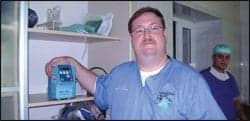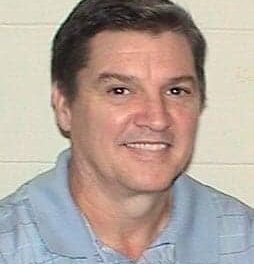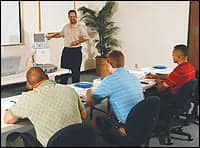 |
| The author comes full circle—this model of an IV pump was the first device he worked on during his internship. |
The medical profession has seen a lot of technological advancement through the years, beginning with analog and progressing into the digital age controlled by microprocessors. Along with these changes, we have seen medical equipment become more advanced and more reliable, resulting in better outcomes. But what if we could go back in time? It is hard to believe that there was an era when most equipment wasn’t as reliable and a biomed emergency was more apt to happen than not; a time when all of our skills were tested, along with a good dose of adrenaline, to produce a positive outcome. Although these advancements are too often taken for granted, there are countries in this world where medical equipment and services seem like a walk back in time.
Since beginning my biomed career in 1986, I have had the opportunity to work with International Children’s Heart Foundation (ICHF, www.babyheart.org), Memphis, Tenn. Our team travels the globe to perform surgery on children with congenital heart defects. One place is the Children’s Hospital in Odessa, Ukraine, where it felt like 1979. Upon arrival, I found one ventilator and one patient monitor functional in surgery and the ICU. The anesthesia unit was built in 1972, and the x-ray unit—built by the old Soviet Union—dated back to the 1960s. Although the equipment was donated from the United States, most of it was in nonworking condition. I cannibalized the donated equipment and created 22 working monitors, along with 8 ventilators. Results: All 16 children went home with mended hearts! We made a difference in these children’s lives, and they certainly made a difference in ours.
 |
 |
 |
| L-R: In Odessa, Ukraine, Soviet era x-ray machine; and also in Odessa, an H-cylinder not tied down in a busy hallway the entire 2 weeks the author was there. | His ventilator test equipment. | |
Most recently, the ICHF team visited Santiago, Dominican Republic, where there were 20 surgeries scheduled. Upon arrival, there were six ventilators, three ESUs, and a heart-lung bypass unit that needed attention. Since two cases were scheduled on the first day of our arrival, there was no time to spare in getting the necessary equipment up to speed.
One of the major concerns on this mission was the country’s power grid. The power goes out up to five times per day with no backup generator—imagine performing surgery with a flashlight. However, surgeries were performed, and again, children’s hearts were mended.
Among them was Kenny. This was a little boy who could not play without getting short of breath and passing out. After undergoing surgery, Kenny walked 100 feet from the ICU to his hospital bed and 4 days postop was home playing with his new football. To describe the joy a parent has when they take their child home can fill volumes of books, which can also describe my journey back in time to mend hearts.
 |
 |
| Med gas system, Odessa, Ukraine. There is the med gas, but which one is the oxygen? They attach their O2 or med air hoses for anesthesia or ventilators. | Odessa, Ukraine, the surgery center. |
 |
 |
| In the Dominican Republic, Roy takes a pump out of a second Sarns 9000 heart-lung bypass unit and puts it in the main unit. “With the power outages, our pumps would shut down and I was able to get them back up by swapping a pump head during a case. This happened three times while I was there.” | Author Roy Morris with an incubator (Dominican Republic) |
Roy Morris is the biomed coordinator in biomedical engineering at Arkansas Heart Hospital, Little Rock. For more information, contact .
What’s on Your Mind?Got a gripe? A recommendation? Does someone or something deserve praise? Share your opinions and insights with your peers. Soapbox columns should be 700 to 750 words in length and can be e-mailed to . |




